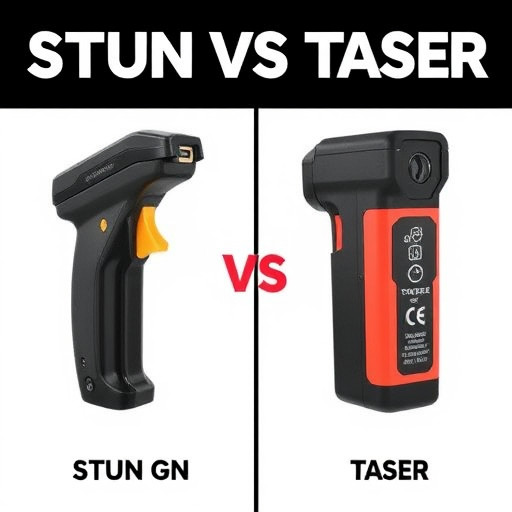This article breaks down the key differences between stun guns and tasers, two popular non-lethal self-defense weapons. Stun guns use metal prongs for direct contact shocks, while tasers fire wired probes to deliver high-voltage pulses from a distance. Tasers offer longer range, versatility, and quicker activation times, ideal for crowded or distance scenarios; stun guns are compact, discreet, but require closer proximity for optimal impact. Legal status and application vary globally, emphasizing the importance of understanding local laws when choosing between these tools for self-protection based on personal preference, comfort level, and anticipated self-defense situations.
In today’s uncertain world, self-protection is paramount. Among the tools at your disposal, stun guns and tasers stand out as popular options for personal safety. Understanding the difference between these devices is crucial. This article delves into the fundamentals of stun guns and tasers, exploring their distinct technologies, effects, and legal considerations. We weigh the pros and cons of each to help you make an informed choice. By considering your needs, budget, and environment, you can select the right self-defense tool—stun gun or taser—and stay safer.
Understanding Stun Guns and Tasers
Stun guns and tasers are both non-lethal self-defense weapons designed to incapacitate an assailant, but they function differently. A stun gun delivers a powerful electric shock through metal prongs or contacts, disrupting muscle control and causing temporary paralysis. It requires direct contact with the target, making it less effective in crowded or unpredictable situations. On the other hand, a taser uses two thin probes connected by wires to deliver a high-voltage, low-current electrical pulse, causing muscular spasms and disorientation. Tasers can be fired from a distance, offering more versatility in self-defense scenarios, especially in areas with many bystanders or narrow spaces where direct contact is difficult.
Understanding the difference between stun guns and tasers is crucial when choosing a self-defense tool. Tasers generally have a longer range and are more effective in diverse settings due to their ability to incapacitate without direct contact. Stun guns, while often more compact and easier to carry discreetly, rely on close proximity for maximum effectiveness. Both weapons have their advantages, and the choice depends on individual needs, comfort level with handling each device, and the specific environments where self-defense may be required.
– Definition and basic functioning of stun guns and tasers
Stun guns and tasers are both non-lethal self-defense weapons designed to temporarily incapacitate an assailant, but they operate on different principles. A stun gun delivers a strong electrical shock through two probes or contacts with the target’s body, disrupting muscle control and causing intense pain. This sudden jolt can disable an attacker long enough for the user to escape or summon help. On the other hand, a taser fires two small probes attached to thin wires, which discharge an electric current upon making contact. The current causes muscles to contract uncontrollably, leading to a loss of balance and temporary paralysis.
The primary difference between stun guns and tasers lies in their mode of operation. Stun guns typically use a direct electrical current that flows continuously until the device is turned off or the probes disconnect. In contrast, tasers employ a shorter, more powerful pulse of electricity delivered through the probes, which can be fired multiple times with a single activation. This distinct functionality influences the level of control and range each offers in self-defense situations.
– Legal status and use cases for self-defense
The legal status and use cases for self-defense weapons like stun guns and tasers vary across jurisdictions, reflecting the ongoing debate around their regulation. Both devices are designed for personal safety, but they operate under different principles. A stun gun delivers a powerful electric shock through metal probes that make contact with the target, temporarily incapacitating them by disrupting muscle control. In contrast, a taser fires two small probes connected to wires, which discharge an electric current, also causing temporary paralysis but often at a greater range and without requiring direct contact.
While stun guns are generally easier to use and carry, tasers offer more reach and power. This difference is crucial in terms of self-defense scenarios: a taser might be preferable in situations where distance or the risk of physical contact with an attacker are factors. Conversely, a stun gun could be more effective for close-quarters defense due to its immediate impact when probes make direct contact. Understanding these nuances and local laws is essential for anyone considering either tool for self-protection.
Key Differences Between Stun Guns and Tasers
Stun guns and tasers are both non-lethal self-defense tools designed to incapacitate an attacker, but they function differently. The primary difference lies in their method of delivery; stun guns fire small electrical probes that attach to the target, delivering a powerful electric shock, while tasers use two probe-less electrodes that discharge an electric current between them, temporarily paralyzing the subject.
Another key distinction is range and effectiveness. Tasers generally have a longer effective range, allowing users to disable attackers from a safe distance. Stun guns, on the other hand, require direct or close contact, making them more suitable for close-quarters situations. Additionally, tasers often have a faster activation time due to their design, offering users an advantage in high-stress scenarios.
